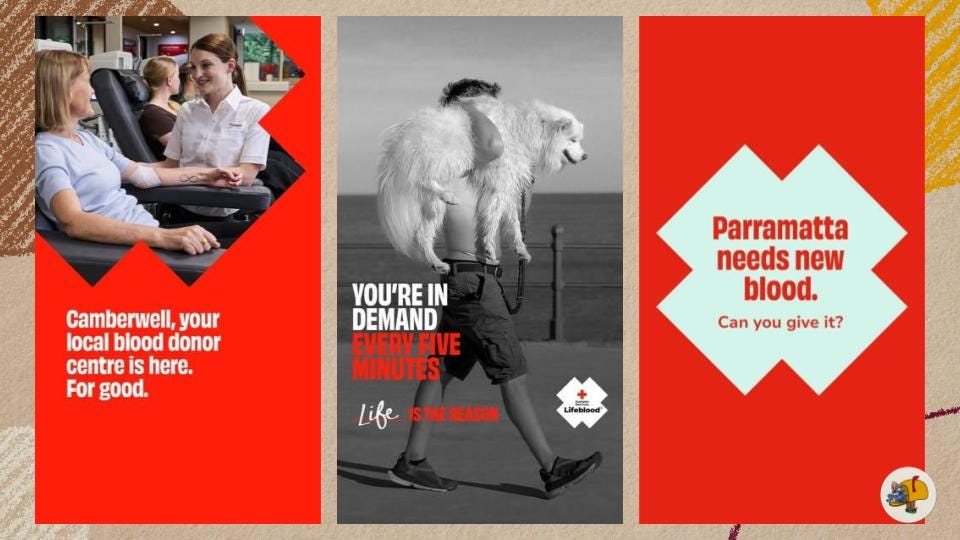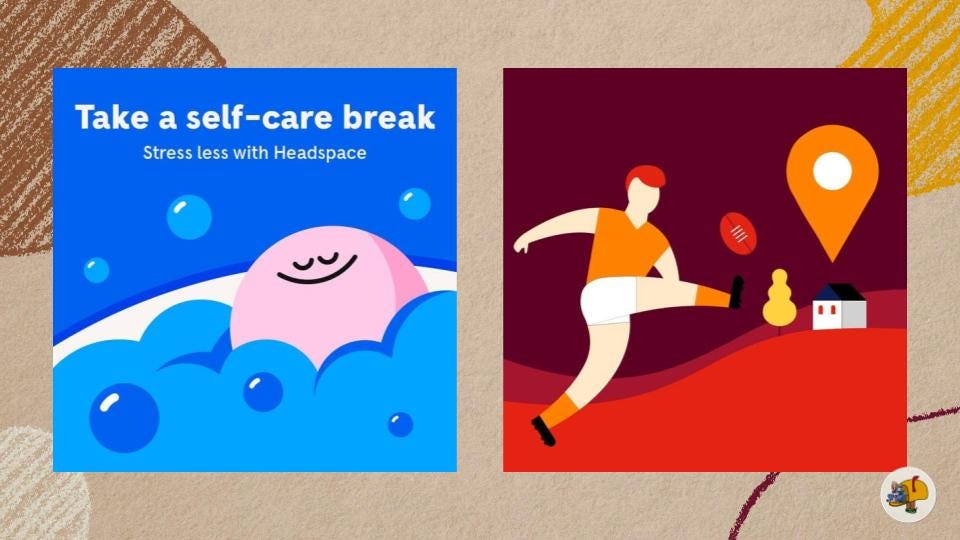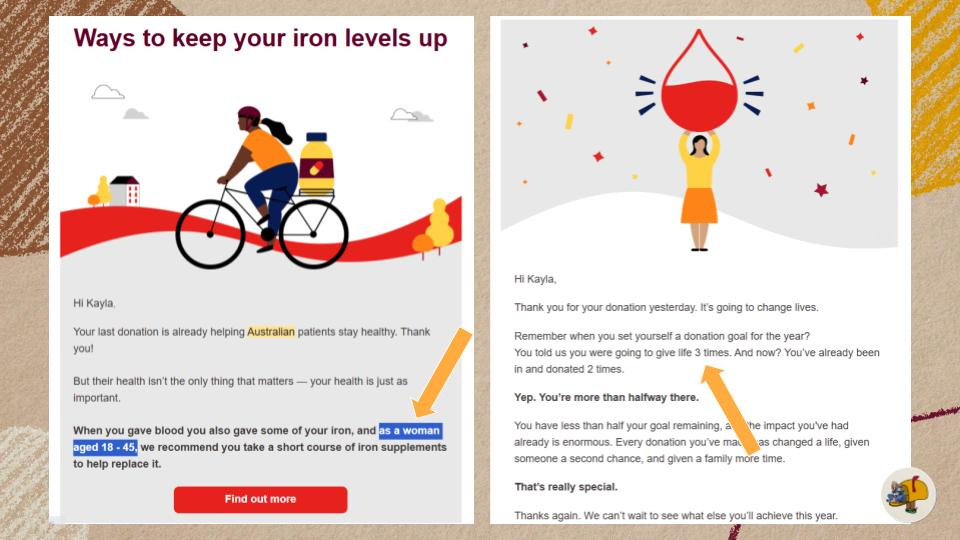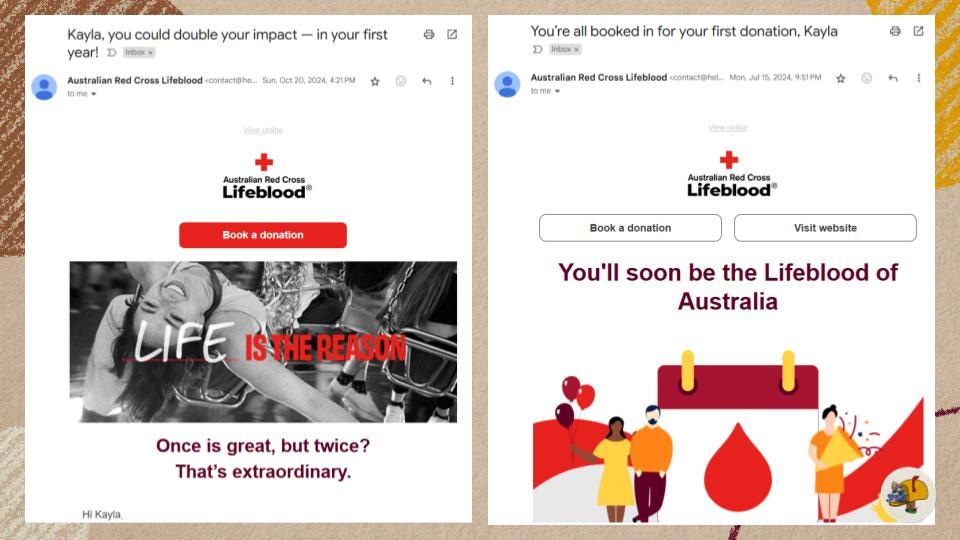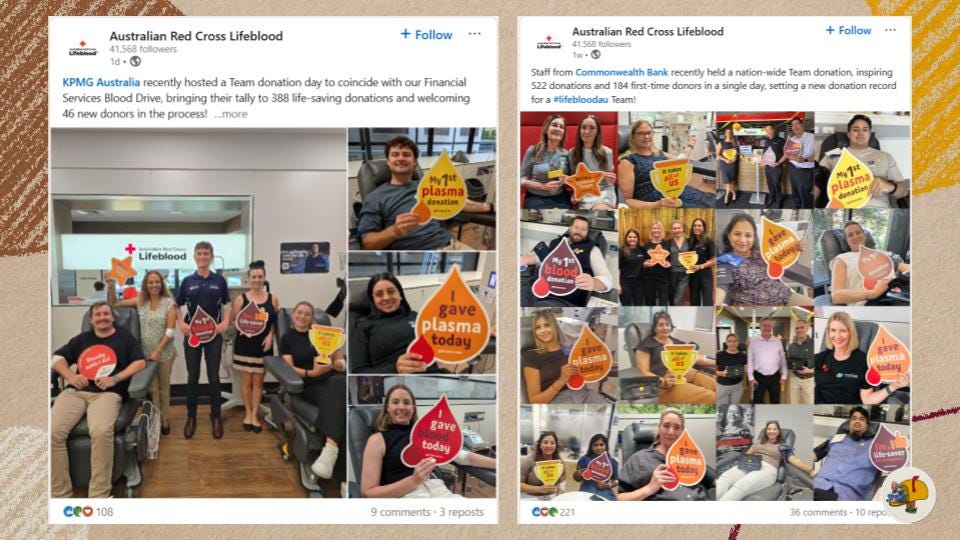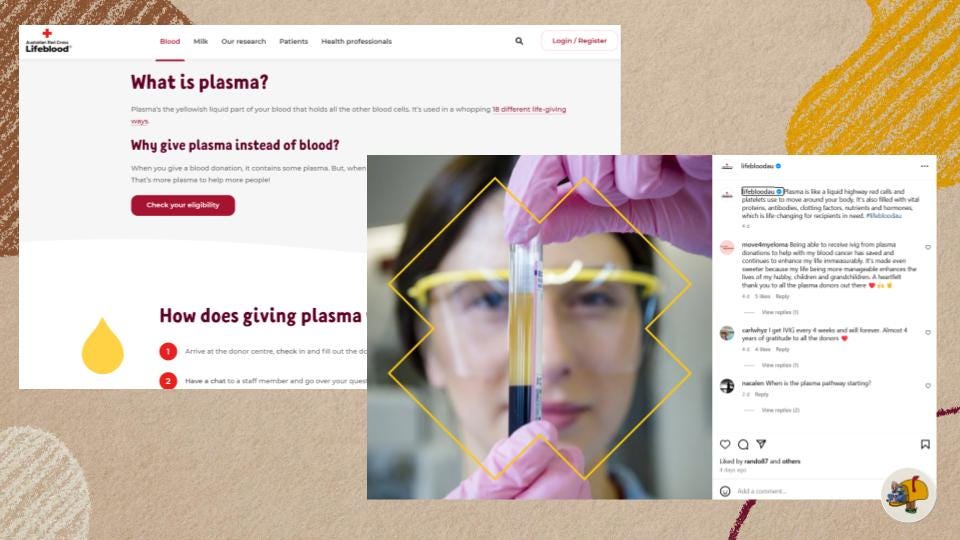Deep dive: Lifeblood's A+ marketing
Season 9, Issue 5: How B2B can steal tactics from not for profit marketers
📬In this issue:
Lifeblood is the blood and non-blood (i.e. tissue, breast milk) donation arm of the Red Cross
Their marketing has really stepped up a notch in the past year or so, across “customer” acquisition, email, content, and even… product marketing!
I do bring it back to B2B, I promise
This is a long one because of images, so might want to open it in a browser.
Roll up a sleeve, Meheketeer,
According to LinkedIn, Lifeblood has has 2,084 employees and 78 of them are in marketing. That’s only 3.7% of the total organisation, and yet they are seriously doing some great work!
I got pulled into Lifeblood’s marketing funnel when I first donated last year, and maybe it’s the Baader–Meinhof phenomenon but I have been seeing some really great marketing from them across so many areas of marketing. So let’s go through it!
Customer acquisition and paid media
In September of 2024, Lifeblood launched their “Life is The Reason” campaign via M&C Saatchi. (Cue tears at how much this probably cost if it wasn’t pro bono and no Mehdeeka reader has this budget.) While I don’t think the slogan is the best — my hypothesis is a non-donator wouldn’t get what this means and therefore it’s not as effective as it could be at converting them into donors — they’ve done a great job with the striking graphics and mixtures of black and white photography and identifiable brand assets with the bright red elements.
They’ve continued to use a lot of these assets in their paid media, mostly on Meta with some ads on LinkedIn!
A lot of this work is likely covered by not-for-profit pro bono agreements with agencies. What we Mehketeers can take away from this though is very similar to the Headspace learning: Identifiable, graphically interesting assets don’t have to be complicated.
There’s another similarity to Headspace — Lifeblood does have some illustrations, though I don’t think they’re as unique and instantly identifiable. Even without the trademark orange, you can still tell it’s Headspace.
Email marketing
This one’s my favourite because 1. they do it really well, 2. it’s most likely being done in house, 3. it’s the one we can take the most learnings from!
I’ve got a total of 34 emails from Lifeblood since I first signed up in July of 2024. Of these:
13 are related to account verification, login codes, and booking confirmations
7 are post-donation follow ups, which include personalised advice for recovering (see example above)
11 of them I’m putting into a general marketing budget. These emails span automated emails reminding you to book in again after a certain amount of time has passed, celebrating when you meet set milestones, information about their rewards program, or content from their blog
1 telling you what your blood type is (I’m A neg)
2 “Spotify wrapped” style emails, one for your personal donation stats and one for Lifeblood’s total stats
First comment: Take out the appointment related reminders and that’s a healthy average of one and a half emails per month. A perfect cadence if you ask me. Contrast this with Headspace yet again — I don’t think they send enough emails.
A negative for the emails is the consistency. Another assumption from me, but this is where the pro bono branding work ended. Having your branding so visually inconsistent can be jarring. Donors are likely too nice to care, but if you’re launching a big campaign, your follow up should be in line with that first impression.
User generated content and social media
This is where I’m going to bring it back to B2B in an unexpected way. From my deep dive on LinkedIn company pages, one of the big purposes of a company page is employer branding. Lead generation and brand awareness are possible but frustrating to do.
Lifeblood does do some B2B marketing, mostly in a partnerships capacity. Organisations that have employee charity programs (i.e. take a day off work to volunteer/donate) can sign up to Lifeblood as a group and have all their employees donate blood together to count towards a team or partake in a blood drive. Blood drives are somewhat competitive, there’s a leader board and teams sign up within their own industry.
Signing up organisations to get their employees to sign up to the company team… is great content for LinkedIn. The organisation gets to flaunt company culture for employer branding, and Lifeblood gets user generated content. I mean, they of course also get life saving blood donations which are far more important than marketing BUT we can get a takeaway from this!
A question for you to consider: How can you encourage your customers to post about you? Not for some token prize, but because you make them look good? How can you get them together for a photo?
Some preliminary ideas are customer office visits, hosting roundtables, running workshops at their offices, or if you don’t want to run events, tell them you’ve bought a table at an awards night or take their team to someone else’s conference and foot the ticket bill.
I’m definitely not suggesting this be a weekly thing. Mix this with your ABM efforts to get targeted customers to post about you, and run this once a quarter, or even twice a year if that’s what your capacity is. This could come under your case study program or be something you offer to do with customers who turn you down for a case study — how else can you build a public relationship with them and use it in place of a formal testimonial?
Product marketing
I got into a comments fight with someone on LinkedIn about the definition of product marketing fairly recently. If you don’t think this is product marketing, you can go write a book about what you think it is and then argue with me.
(This is my reminder that I did write a book about product marketing and you can buy it.)
There’s a complicated product-customer relationship with Lifeblood:
Donors are not the customer, but they do need to be marketed to like a customer
The product (the donations) come from the donor and go to the customer
The customer (hospitals, medical research) don’t pay for the product
That context set, I do think all the work they do around educating their audiences on what the different types of donations are and what they’re used for count as product marketing.
If the title of a piece of content includes “What is ___”, “How does ____ work”, or “Why you should ___” then it’s product education. And that’s what Lifeblood does!
It’s really excellent that they’re managing to cover so much. I know this is the work of 70+ in house marketers but that is actually about the same as Headspace.
Honorable mentions
Their social media team is great, and has genuine responses and chit chats when you tag them in your stories. The rewards program is top notch and they also do a bit of building in public with that which is cool to see. The “Life is the Reason” campaign was also distributed in out of home placements including billboards and bus stops. They do also run ads on Google, do a bunch of organic content, have celebrity endorsements (including Olympians!) and a sporting partnership with the Sydney Swans.
Is all of this working?
There’s a noticable uptick in Lifeblood’s internet traffic that matches the timing of the campaign. Since bookings are made online, we’d be safe to assume that even if their conversion rate from web visit to booked donation stayed exactly the same, they’ve seen an increase in donations.
The low on this graph is 112,000 monthly visits, and the peak is 191,000. It’s still rising, and given they gained 20,000 visits between February and March, it won’t be long before they’ve doubled their traffic.
Lifeblood has been vocal about needing more donors to meet demand, and that literally means saving lives. If a government funded organisation tasked with saving lives can see how important it is to invest in a comprehensive marketing strategy to drive their goals… then maybe us B2B marketers with huge targets and tiny budgets can show this to our stakeholders and convince them that long term investment is worth it.
And if that fails, you can always donate blood and save a life!
Kayla




